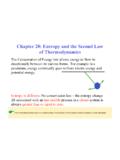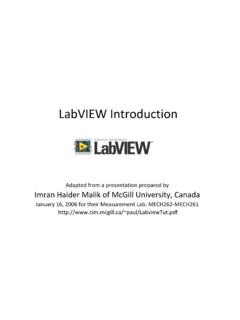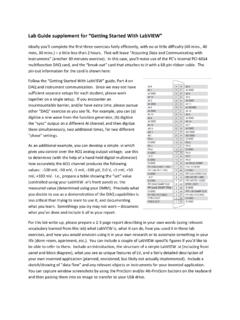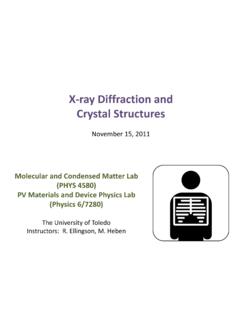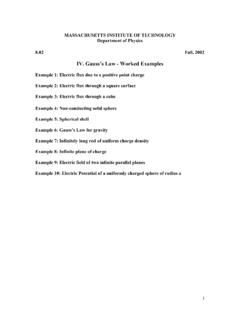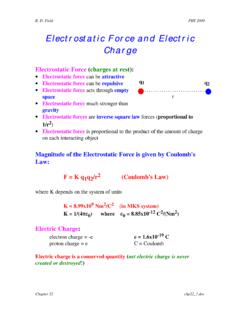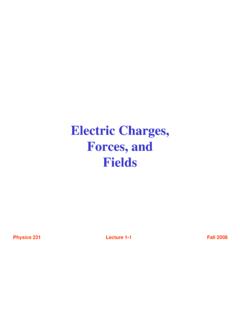Transcription of Chapter 22: The Electric Field - University of Toledo
1 Read Chapter 22 Do Ch. 22 Questions 3, 5, 7, 9 Do Ch. 22 Problems 5, 19, 24 Chapter 22: The Electric FieldThe Electric Field Replaces action-at-a-distance Instead of Q1exerting a force directly on Q2at a distance, we say: Q1creates a Field and then the fieldexerts a force on Q2. NOTE: Since force is a vector then the Electric Field must be a vector Field !E EqF Does the Field really exist?It exists due to the finite speed of light (maximum speed of signal propagation) Electric charges inisolating shells1 Isolation removed(door open)234 Force is exerted after the source charge is isolatedInteraction by the Field rather than by chargeField E is defined as the force that would be felt by a unit positive test charge0/qFE SI units for the Electric Field : newtons per Field Lines Lines point in the same directionas the Field .
2 Density of lines gives the magnitude of the Field . Lines begin on + charges ; end on charges . We visualizethe Field by drawing Field are defined by three properties: Electric Field created by a negatively charged metal sphereCoulomb s Law for the FieldEqrrqQkF 2rrQkE 2 Coulomb s law for the force on qdue to Q:Coulomb s law for the Field E due to Q:Example 1 What is the Electric Field strength at a distance of 10 cm from a charge of 2 C? )1010()102)(109(5132692 So a one-coulomb charge placed there would feel a force of 180,000 point charge Q is far from all other charges . At a distance of 2 m from Q, the Electric Field is 20 N/C. What is the Electric Field at a distance of 4m from Q? N/CAdding fields Principle of superposition Electric fields due to different sources combine vector addition to form the one true total Field .
3 321 EEEE1Q3Q2Q3E 2E 1E E Example 2-2Q Q x y d the Electric Field on the yE2221)(2dxkQxkQEEEx 2. Where will the Field be zero? The shell theorems for EIn Chapter 13 we had the shell theorems for gravityIn Chapter 21 (p. 567) the shell theorems for electrostatics were Chapter 23 (p. 618) they will be we can easily understand them now from our knowledge of Electric Field shell theorems for gravityGiven a uniform spherical shell of mass:(1) The Field outside is the same as if all the mass were concentrated at the center.(2) The Field inside the shell is zero.(These theorems for gravityare given in Chapter 14.)(Newton s headache!)Prove true also for Electric fieldUse our knowledge of Electric Field lines to draw the Field due to a spherical shell of charge:There is no other way to draw lines which satisfy all 3 properties of Electric Field lines, and are also spherically symmetric.
4 Notice that both shell theorems are obviously r Qspread over shell point Qat center!sametheareratFields PROOF: (1) Spherical symmetry(2) Fields far away must be equalUseful result for spherical symmetryr Field outside a sphere of total charge Q is radially outward with magnitude2rkQE shell of uniform charge attracts or repels a charged particle that is outside the shell as if all the shell s charge were .. at the at the point closest to the at the point opposite the Dipole The combination of two charges of equal but opposite sign is called a dipole. If the charges +q and q are separated by a distance d, then the dipole moment is defined as a vector pointing from q to +q of magnitude p = qpq Electric Field Due to a DipoleTorque on a Dipole in a Field sinsin)sin2(2pEdqEdF Ep Chapters 22, 23: The Electric FieldNOTE!
5 If you have urgent questions, please send me e-mail with Your name SectionAt Electric Fields Definition of Electric Field :F = qESI unit: newton per coulomb (N/C) Coulomb s Law for a point charge Q:F = kQq/r2 ORE = kQ/r2 Principle of superposition (vectoraddition): 321 EEEEnetElectric Field Lines Lines point in the same direction as the Field . Density of lines gives the magnitude of the Field . Lines begin on + charges ; end on charges . We visualizethe Field by drawing Field are defined by three properties:From these properties it is easy to see that Field lines never crossCoulomb s Law for the FieldEqrrqQkF 2rrQkE 2 Coulomb s law for the forceon qdue to Q:Coulomb s law for the fieldE due to Q:ExampleThree point charges are placed on the yaxis as the Electric Field at point P on the 1E 2E 32EE 3E 22322baQkEE 222232/2cos2)(babEEEEx 22/322132/)/(4)(bkQbakQbEEEExx 0 yE321 EEEE per per per meterWhat is the SI unit for the Electric Field ?
6 Is the SI unit for the Electric Field ? Field is force per unit charge:EqF per per per meterThree charges (one + and two -) are placed on the xand yaxes as shown. What is the approximate directionof the Electric Field at the origin? Will it be pointing toward point 1, 2, 3, or 4? + (1)2.(2)3.(3)4.(4)-q2-q+ +q413 EThree charges (one + and two -) are placed on the xand yaxes as shown. What is the approximate directionof the Electric Field at the origin? Will it be pointing toward point 1, 2, 3, or 4?Solution. Imagine a positive test charge placed at the origin. It will be atracted to the q charges and repelled by the +q charge distribution Linear charge density= charge per unit length If a rod of length m has a uniformlinear charge density = 3 C/m, then the total charge on the rod is ( m) (3 C/m) = C.
7 If a rod of length L carries a non-uniformlinear charge density (x), then adding up all the charge produces an integral: babadxxdqQ)( Example: Ch. 22 Prob. 3222,./rdrkrdqkdEdrdqThenLqLet rdrdq LaakrkrdrkdEELaaLaa1112 Find the Electric Field at point density is not uniformrdrdq LaardrrkdEE2)( 22,rdrkrdqkdEdrdqthattrueStill Field of a charged ringUniform linear charge density so dq = ds and dE = kdq/r2By symmetry, Ex=Ey=0 and so E = Ez = sum of all dEz, and dEz = cos Charged ring continued2/3223)(/cosRzkQzrkQzEsorzBut 22coscosrQkrdqkE Charged ring result2/3223)(RzkQzrkQz 22coscosrQkrdqkE NOTE: This is a good example of a special result, which is the answer to an example problem, not a fundamental principle to be memorized.
8 It is the processwe are supposed to be learning, notthe result!NOTEThis result for the Field on the axis of a charged ring can be derived more easily in Chapter 24 using the idea of Electric Dipole The combination of two charges of equal but opposite sign is called a dipole. If the charges +q and q are separated by a distance d, then the dipole moment is defined as a vector pointing from q to +q of magnitude p = qpq Electric Field Due to a DipoleTorque on a Dipole in a Field sinsin)sin2(2pEdqEdF Ep Gauss s Law Gauss s Law is the first of the four Maxwell Equationswhich summarize all of electromagnetic theory. Gauss s Law gives us an alternativeto Coulomb s Law for calculating the Electric Field due to a given distribution of s Law: The General IdeaThe net number of Electric Field lines which leave any volume of space is proportional to the net Electric charge in that VE lines leaving VE lines entering VFlux SAdE The flux of the Field E through the surface S is definedasThe meaningof flux is just the number offield linespassing through the Statement of Gauss s LawThe outward flux of the Electric Field through any closed surface equals the net enclosed charge divided by s Law: The Equation SencQAdE0/ S is any closed surface.
9 Qencis the net charge enclosed within S. dA is an element of area on the surface of S. dA is in the direction of the outward Previous Homework: Read Chapter 22 Do Ch. 22 Questions 3, 5, 7, 9 Do Ch. 22 Problems 5, 19, 24, 34 Chapters 22, 23: The Electric Fiel

